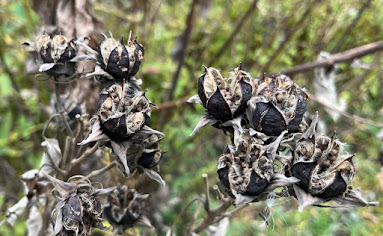November is when woodlands turn into one of those paintings where you match the color to the number. It's a time when you can gaze into the distance and identify every woody plant by its color. For instance, in this photo of a woodland overlooking the canal in Kingston, check out the yellow in the upper right. That's what's left of the Norway maple leaves, which turn color later than the native maples, and seem to know no other color than yellow in the fall. And the green in the understory? That is bush honeysuckle--what I call the "second forest." It's still green because it evolved on a different continent with a different climate, and so its timing is different from the native flora in spring and fall.
Seen this past week from the cliff in Herrontown Woods, the color coding was much more complex, with non-native Photinia, winged euonymus, and bush honeysuckle mixing with native species.
Here's a glorious dogwood along the red trail.
Up on the ridge, the maple-leaved Viburnums develop subtle shadings.
In our "cultural zone" between the Barden and Veblen House, young white oaks turned a rich burgundy earlier in the month. I tell people it's called a white oak because it turns red in the fall. Red oaks mostly turn orange. Naturalists have been doing Stop Making Sense tours long before David Byrne got around to it.
And then there's Photinia villosa, which is both beautiful and concerning, given how densely it has come to dominate in areas across town in Mountain Lakes and the Institute Woods. A few specimens turn bright orange, while
most turn bright yellow, even when growing side by side. You won't see a Norway maple going rogue with orange in the fall.
Here you can see Photinia (yellow), American holly (evergreen), and in the foreground some sweetgum leaves (red). You can see how empowering the color coded forest is for distinguishing one species from another.
Barberry is beautiful as well. If only wildlife could feast on beauty, we'd be all set.
You can see the long awn on the seed that gives this grass an attractive look, as if it has fancied itself up with long eyelashes. The coppery background leaf is beech, which will keep its leaves far into the winter, a reminder of November's color-coded artistry.


























